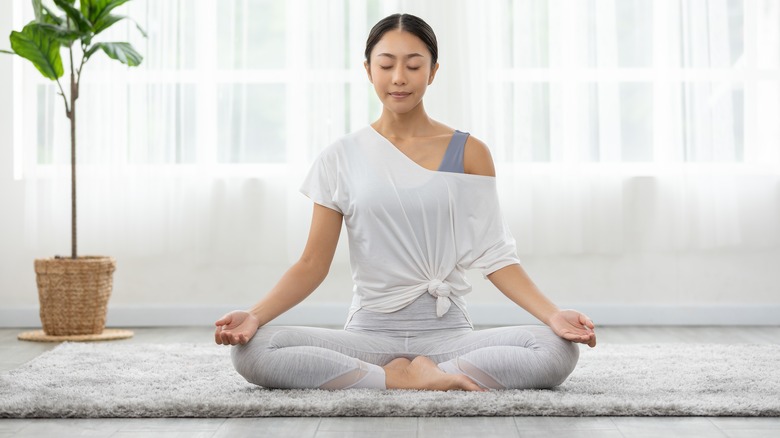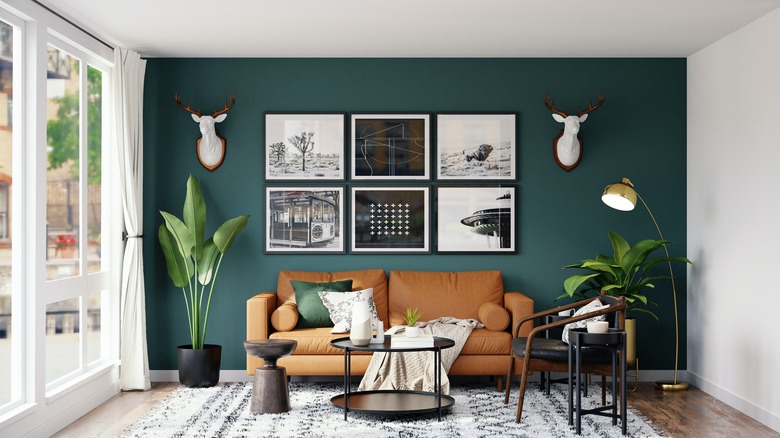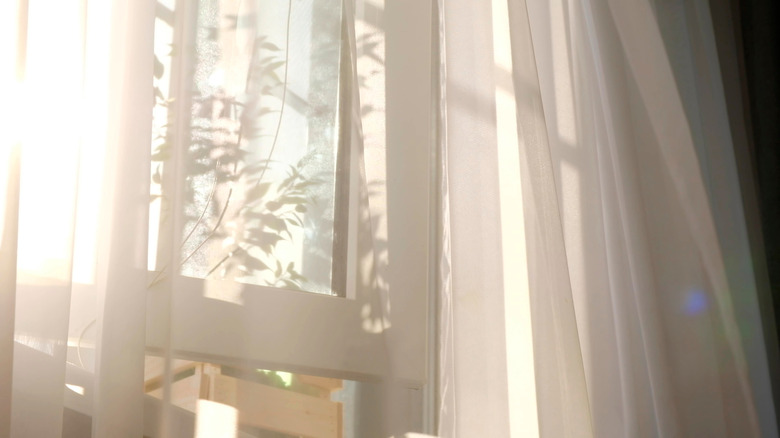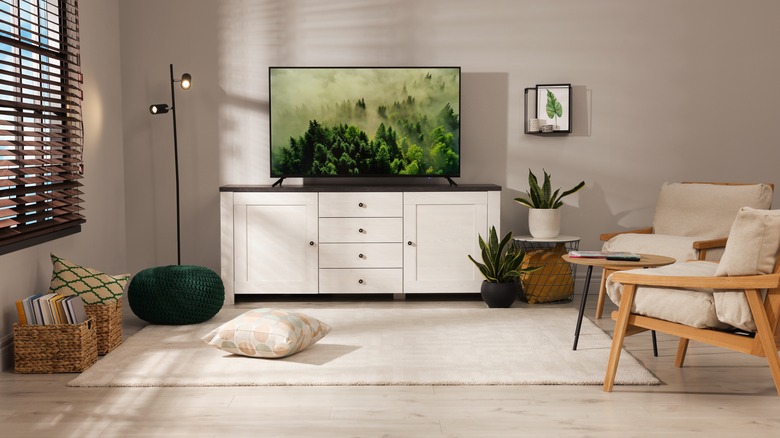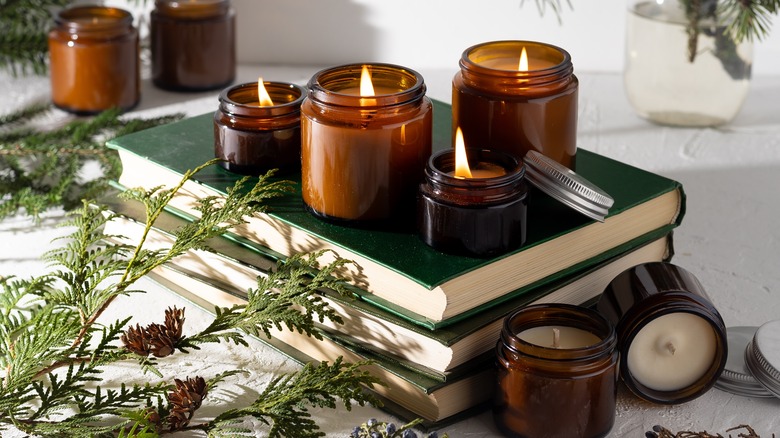How To Make The Ultimate Self-Care Space In Your Home
In today's hectic world, making time for self-care is more important than ever, but it is also becoming more difficult than ever. One of the most effective ways you can put taking care of yourself on the top of your to-do list is to build an area for self-care directly into your place. Whether this area is a corner of an already-existing room, such as a cozy reading nook tucked into your living room space, or you are lucky enough to be able to dedicate an entire room as a meditation zone or journaling area, designating a spot as exclusively intended for self-care can be the first step towards prioritizing your own mental wellness.
Michigan Tech defines self-care as anything that benefits your mental, physical, or emotional health. Keeping that definition in mind is the first step towards building a successful self-care space inside your home. So, what is best for you and your own health needs? Is it a space that is quiet, reclusive, and tucked away from the rest of your house? Or is it an area with bright light and airy windows that makes you feel connected to the outside world? Whatever your specific self-care needs are, there are a couple of qualities you should always keep in mind when designing this space.
1. Plan out your color scheme
Before you get started on any other component of your self-care space, you should first determine what color palette you are going to emphasize when designing your safe sanctuary area. According to Color Psychology, the colors in our environment do a lot more than signal the rods and cones in our eyes — they also impact our brain and mood. So when envisioning your self-care space, it's important to consider what mood and ambiance you are trying to create.
If this is an area intended for you to relax and decompress, an ideal color to incorporate would be different shades of green. As Color Psychology explains, green evokes humanity's primal connection to nature, taking us outside of our busy work and personal lives and making us feel as though we're alone in a serene, lush forest. Viewing the color green can even slow down your metabolism!
If you are interested in making your self-care space an area not just for you to relax and decompress but also a space where you can do some self-work, such as meditation and journaling, you are going to want to bring in some blue. Blue evokes stillness and tranquility, often reminding us of bodies of water. But, like all bodies of water, blue also symbolizes depth and reflection, making it ideal to inspire you to try to understand yourself and your wants better. So, if you want your self-care space to center you, blue is an excellent choice.
2. Focus on lighting
Once your color scheme is finalized, you want to ensure your space is properly illuminated to maximize those color benefits. Lighting also plays a huge role in setting up the proper atmosphere for a self-care space — the absolute last thing you are going to want is any kind of harsh overhead light or even a floor lamp that is just a little bit too bright.
As The Design Tourist reports, the best kind of lighting to promote a relaxed, reflective vibe is a softer type that creates more shadows, such as string lights, twinkle lights, or even different colored lights (another opportunity to focus on color psychology!). If you do use traditional lamps, make sure you choose your shades carefully to ensure they filter out enough light to maintain a cozy atmosphere.
The best lighting source for a self-care space that you plan to use during the daytime is, of course, natural light. As Healthline explains, not only does it boost your mood, but it also provides a number of health benefits. For example, spending time in natural light connects you more to the natural rhythms of daylight and nighttime, which can help you sleep better at night. It also increases your vitamin D levels, which have been associated with a reduced risk of obesity, osteoporosis, heart disease, and even cancer! So, spending time in a self-care space with a window can be better for you than you might realize.
3. Choose your furniture carefully
Your furniture should also reflect your intent for your self-care space. If you are someone who relaxes more in an open and airy area, aim for a minimalist vibe with your furniture choices, including only what is necessary for the space. If you feel more comfortable and in tune with yourself, if you are snug and cozy, design your space to feel close and comforting.
Regardless of what overall vibe you create for your self-care space, it can be helpful to think about the process of grounding yourself. As Insider reports, the act of grounding, or focusing on the present moment and your surroundings as opposed to what is going on inside your head, can be a critical component of promoting mental health, especially if you experience conditions such as anxiety or post-traumatic stress disorder that can make you feel stuck inside your brain. Your furniture choices can remind you to ground yourself and even aid you in this act.
If you pick furniture made of solid, natural material such as wood or stone, the rougher feel and sometimes even the scent of such furnishings can bring you back to reality when your mind may be spinning out. It may sound silly, but grounding can sometimes literally mean simply connecting with the ground, so incorporating furniture that is low-slung and closer to the ground, such as floor cushions, can help you reconnect with the present moment and your own body.
4. Bring in houseplants
The mental health benefits of houseplants have pretty much been proven beyond a reasonable doubt at this point. As The Washington Post describes, bringing houseplants into a space reinforces the human connection to nature and the natural world, which can sometimes get lost in our day-to-day lives.
Cultivating houseplants can help you to reconnect with yourself — and can aid in the process of grounding. Caring for indoor greenery is an activity that does not require a lot of time and effort but can still bring you out of your head and into the present moment. So which houseplants are your best choices for your self-care space? The Washington Post recommends at least one taller houseplant (defined as 5 feet high or more), whose size can make you feel even more like you are out in the forest — particularly if you position it next to floor cushions so that it towers above you as you meditate or read one of your favorite books.
In a similar vein, you should focus on plants that bring in as much green as possible, which is another way to make the most of what could end up being a small space. Options such as ivy are a great choice for maximizing greenery, while brightly colored flowers can help boost your mood. If your self-care space lacks sunlight and you're finding it difficult to cultivate live houseplants, some research has shown that artificial plants can still improve your mental health (via Artificial Eden).
5. Don't forget your other senses
So much of building a self-care space is emphasizing what you see in the space itself — the colors, the lighting, the furniture options, and any greenery. But it's important to think about your health and body holistically, which means bringing in self-care aspects that play to your other senses beyond your vision.
For example, as The Guardian reports, proximity to water can be a game-changer when it comes to both mental and physical health. So, installing a small water feature — even something as simple as a desktop fountain — in your self-care space can provide soothing background noise and once again make you feel more connected to nature (notice a theme here yet?).
Another sense you can embrace when cultivating a self-care atmosphere is your sense of smell. As The Design Tourist explains, aromatherapy can significantly affect a person's psychological well-being. Adding scented candles or even an essential oil diffuser to your self-care area can help relax you — and you may even start to associate certain smells with your own quiet, reflective space, meaning encountering those smells in other settings could be relaxing for you as well.
Popular relaxation scents include lavender, tea tree, lemongrass, and others that evoke relaxing places, whatever that means to you. For example, you could find leisure with a forest scent or one that brings to mind a warm, cozy bakery. You could even bring in a happy scent from your childhood, like vanilla cookies. The possibilities are endless!
